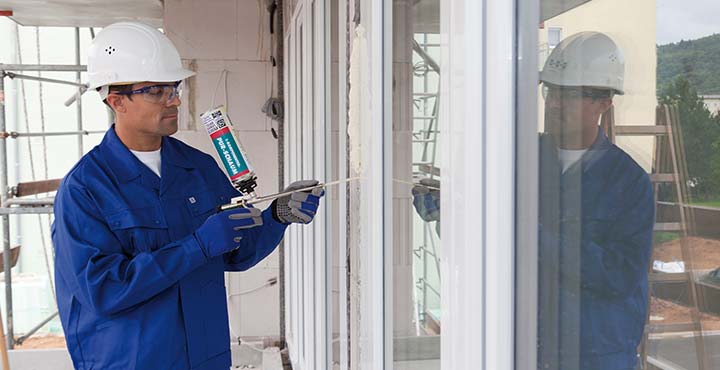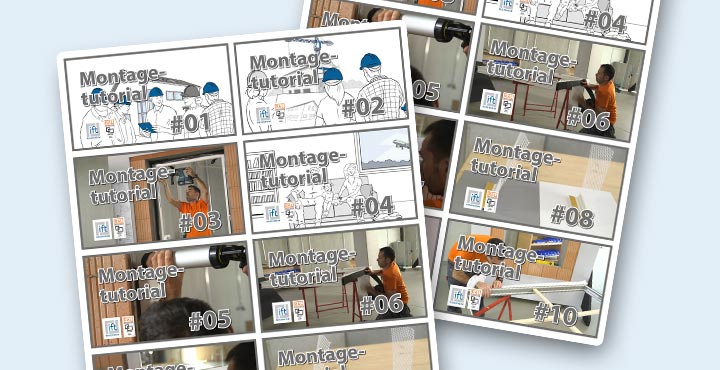
What does window foam need to be able to do?
As specified in the Energy Saving Ordinance, new buildings should have an airtight building envelope. This means that the window itself should not only meet all defined energy ratings, the joint between the window frame and the wall must also remain consistently tight for decades.
Professionals achieve this by combining various sealing substances. One of the main products used to insulate window joints is PU foam. Today, about 80 percent of all windows in Germany are fitted and insulated with PU foam. What distinguishes a good window foam?
Why the PU foam should be expandable
How you can recognise flexible construction foams
How to check the quality of window foam
Interview: Installing windows just with PU foam – is that possible?
RAL Window Fitting Guide
Why the PU foam should be expandable

Flexible construction foams are highly suitable for fitting windows. The reason? Because the size and position of the frames change when exposed to wind, heat or cold. In the case of south-facing windows, there may be temperature differences of up to 100 °C. The material heats up in the summer and cools down again in the winter, and the frame expands and shrinks accordingly.
Compensating joint expansion
For instance, the frames of aluminium windows can change by up to one millimetre per running metre under various climatic conditions. PVC windows may even change by up to two millimetres. Also, the foam always connects two different materials that have varying expansion behaviours, which is why a certain amount of joint movement can always be expected.
The window foam needs to be able to cope with all these factors without tearing.
How you can recognise flexible construction foams
Flexible PU foams can usually be identified by their product name. for instance, when variations of the terms ‘flexible’ or ‘elastic’ are used. If the product name on the can gives no indication, take a look at the product data sheet. The flexibility of the foam is stated as the compression force. Here, conventional foams usually lie between 30 and 60 kN (Kilonewton); elastic window foams should lie below 20 kN.
How to check the quality of window foam
One visible quality feature is the consistency with which the foam leaves the can. Ideally, it should look like whipped cream. Oily or viscous foams are indications of an inferior product. It is also important that the PU foam adheres well to the surface immediately and does not run into the joint. Specialists refer to this behaviour as staying put and/or slipping. Only foam that adheres well ensures even insulation and distribution.
Fine-pore and even
Another quality feature becomes apparent when the foam hardens. When the excess foam residues are cut off with a knife, the foam structure becomes visible. The finer the pores and the more even they appear, the better the thermal insulating properties. Ideally, the foam structure should resemble a foam mattress.
Does window foam that has turned yellow still insulate correctly?
Window joints that are insulated with PU foam need further insulation. The fitters do not always carry out this work immediately. As a result, the light-sensitive PU foam turns yellow, becomes brittle and can be scratched off easily. This raises the question as to whether it can still fulfil its insulation function.
Time plays an important role here. There are no problems if the sealing is applied within a few weeks. During this time, the changes are purely superficial and more of a cosmetic problem. The foam is still completely intact below the upper layer. Before the fitter seals the joints finally, they need to remove the discoloured PU foam layer.
If the foam has been exposed to UV radiation for more than a few weeks, it will become brittle and gradually lose its good insulating function. After several years exposed to light, it can completely disintegrate. PU foam that is protected from light is decay and rot-proof, and offers reliable insulation for decades.
Interview: Installing windows just with PU foam – is that possible?
Time and again, there are reports stating that windows can be installed and insulated only with the help of PU foam. Other contributions, by contrast, explicitly point out that this is not possible. So which is it? The PU Foam Info Centre asked the German expert for professional window installation, Dipl.-Ing. Wolfgang Jehl from ift Rosenheim..
 Dipl.-Ing. Wolfgang Jehl
Dipl.-Ing. Wolfgang Jehl
Mr Jehl, what is the function of building foam when it comes to window installation? What can it do, and what not?
In short: PU foam insulates! It ensures that the joint between the window frame and the wall is characterised by good and continuous thermal insulation. In doing so, in winter the heat stays inside the house and the cold outside. In summer, of course, the reverse is true. PU foam is very well suited for insulating joints thanks to its excellent insulation properties.
And what about fastening – is PU foam effective when it comes to this, too?
It is helpful. Anyone who has ever installed a window can confirm that a window insulated with PU foam fits more snugly in the recess. The foam sticks to the edges of the joint and thus connects the window frame with the wall. This is a welcome side-effect, but you cannot take this into account statically. In order to fix a modern window securely and permanently in place, you cannot do without suitable mechanical fasteners such as screws, dowels and the like. This also applies to all other insulation materials. By the way, when we use the term “permanent”, we mean the typical service life expectation for windows, on average 40 years.
The question remains as to the tightness of the window joint ...
The same applies here as for the fastening. Of course, a joint that has been filled with PU foam is tighter than a joint that has not yet been insulated. If the foam is well bonded to the window frame and the wall, i.e. both joint flanks are glued together, this also has a very positive effect on the joint sound insulation. But this alone is not enough to permanently seal a joint according to the rules of technology.
Why?
The joint must be airtight all around on the warm side, i.e. the room side, in order to prevent the air from flowing through the joint and thus to stop both heat loss and draught. The special feature is that the window connection joint is always a movement joint. You, therefore, need sealing products that can accommodate all the expected movements of the joint and still retain their sealing function. Further steps are, therefore, necessary to ensure that the joint is permanently airtight. Tradesmen often resort to joint sealing tapes, joint sealing foils or sprayable sealants. However, there are also other suitable materials.
And from the outside – what steps are necessary?
From the outside, we need a so-called driving rain-proof connection, which prevents water from penetrating the joint during heavy rain and wind. As a rule, the joint is also sealed here with specially suitable, movement-absorbing sealing products (see above). But be careful: the waterproofing products inside and outside should be matched to each other in such a way that any moisture that may occur in the joint can be wicked away to the outside. In addition, there are measures with which rainwater can be drained off in a controlled manner, for example, window sills. What exactly needs to be done here depends to a large extent on the elemental forces to be expected for the window in question.
No matter how many work steps are required to install a window in accordance with RAL, is PU foam still used for joint insulation?
Oh yes, I assume that around 80 per cent of the windows installed in Germany are insulated with PU foam.
Why do window fitters still reach for installation foam so often?
To install a window according to the rules of technology means to fix, insulate and seal (see e.g. VOB/C ATV DIN 18355, Joinery, Section 3.5, Installation), it always requires professional and careful processing and execution in addition to a suitable choice of materials. As previously mentioned, these are, of course, the great insulating properties of PU foam, i.e. its low thermal conductivity. Furthermore, it is very efficient and economical to process. The ift investigated this particular aspect in a study in 2005. Compared to insulating materials that are stuffed into the joint, joint insulation with PU foam is at least twice as fast. In unfavourable installation situations, it can even be up to five times faster with PU foam. For example, when you are dealing with uneven, difficult to access joints in an old building.
And what's with the “miracle foams” that are reported on again and again?
It is true that a few suppliers advertise that their foam can cover all the necessary functions on its own. I can only say from my own experience that no such foam has ever been successfully tested in this respect at the ift Rosenheim. We have been developing test methods for several years. However, to date, no foam has been presented to our institute that has passed all the necessary tests.
About Wolfgang Jehl
Dipl.-Ing. (FH) Wolfgang Jehl, Product Manager for assembly, windows and external finishes at ift Rosenheim. As an expert, he is in charge of preparing the RAL guidelines for the planning and execution of the installation of windows and front doors for new buildings and renovations.
Please note:

Selection of the right PU foam is an important factor for professional window fitting. Window fitting also includes other important steps that cannot be illustrated here. The RAL Window Fitting Guide itself is 300 pages long. For more information, please refer to e.g. the window and façade association.
To find out more, please visit the ift Rosenheim website. These ten free detailed video tutorials explain how to mount windows step-by-step.
The videos financed by the non-profit ifz Rosenheim are available here

![[Translate to Englisch:] Zargenschaum, Innentüren [Translate to Englisch:] Zargenschaum, Innentüren](/fileadmin/PU-Schaum-Center/PU-Schaumarten/img_PU-Schaumarten_Zargenschaum_Innentueren.png)
![[Translate to Englisch:] PU-Schaum richtig verarbeiten [Translate to Englisch:] PU-Schaum richtig verarbeiten](/fileadmin/PU-Schaum-Center/PU-Schaum_in_der_Praxis/img_PU-Schaum_richtig_verarbeiten.jpg)
![[Translate to Englisch:] Bauschaum entfernen [Translate to Englisch:] Bauschaum entfernen](/fileadmin/PU-Schaum-Center/PU-Schaum_in_der_Praxis/img_Bauschaum_entfernen.jpg)

